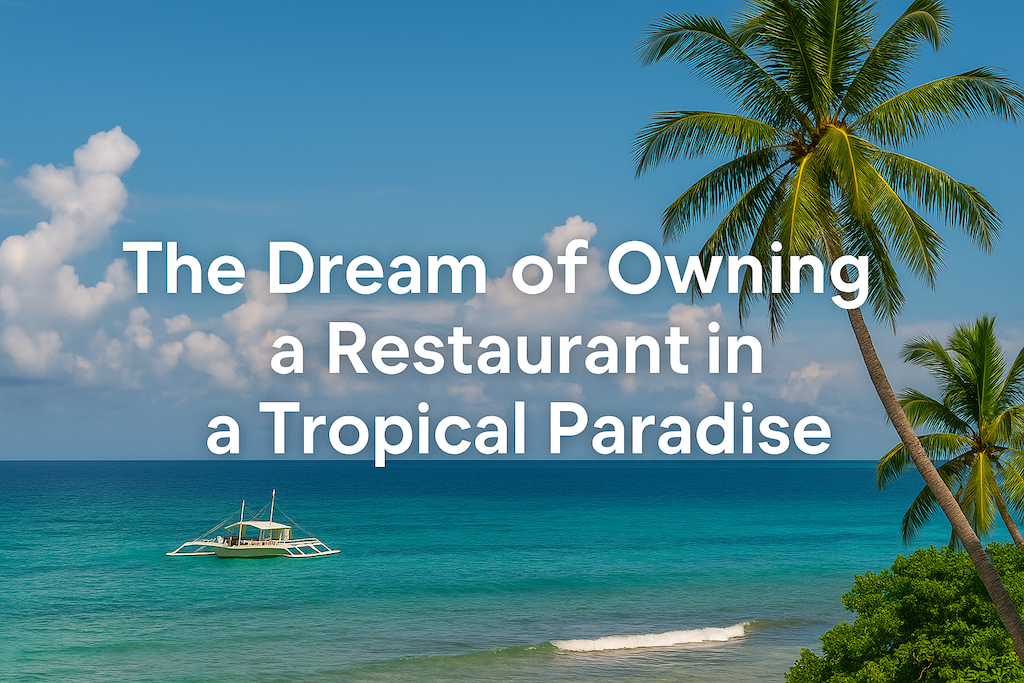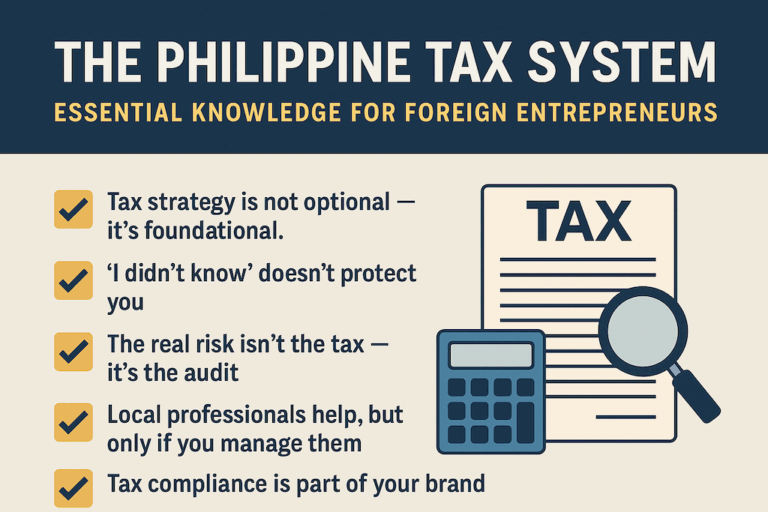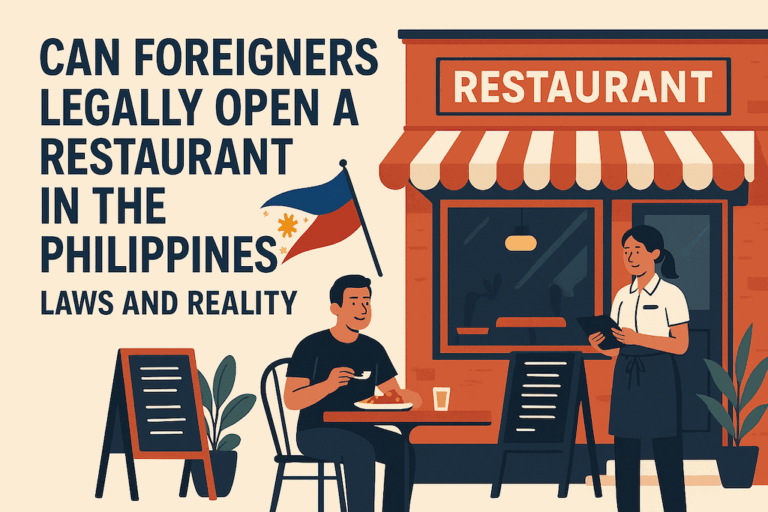Introduction: The Dream of Owning a Restaurant in a Tropical Paradise
✅ Introduction: The Dream of Owning a Restaurant in a Tropical Paradise
Many aspiring entrepreneurs dream of opening a seaside café, combining overseas living with a food business, or launching a restaurant abroad and bringing that success back to their home country.
Cebu, Philippines, often appears ideal for such ambitions. With relatively low living costs, affordable labor, and a growing interest in international cuisine, the island attracts tourists, international students, and affluent locals—seemingly a perfect market for new restaurants.
However, turning this dream into a successful business is far more challenging than it looks. In this article, we’ll walk you through the actual steps of starting a restaurant in Cebu, and reveal the hidden pitfalls that foreign entrepreneurs should be prepared for.
✅ How to Legally Operate a 100% Foreign-Owned Restaurant in the Philippines
Under Philippine law, foreign ownership of restaurants is generally prohibited. According to the Retail Trade Liberalization Act and the Foreign Investments Act, food and beverage businesses fall under the Foreign Investment Negative List, which restricts or bans foreign equity in certain industries.
However, there is a possible—but difficult—path for full foreign ownership, if specific conditions are met.
✅ Conditions for 100% Foreign Ownership
To legally operate a 100% foreign-owned restaurant, a business must:
-
Have a minimum paid-up capital of USD 200,000 (approx. PHP 11 million)
-
Employ at least 50 Filipino workers or demonstrate comparable high value-added services
If these requirements are fulfilled, foreign investors may apply to legally register a restaurant business under their name. However, this approach involves major hurdles:
-
Submission of business plans and capital documentation to agencies such as BIR, DTI, and SEC
-
Ongoing proof of employment and compliance
-
Approval as an exception to domestic market restrictions, subject to close scrutiny
For this reason, most small or mid-sized restaurants cannot realistically qualify, and foreign entrepreneurs often turn to a more practical—but risky—alternative.
🔍 Summary: Normally Prohibited, But One Legal Path Exists
| Capital & Setup | Foreign Ownership | Notes |
|---|---|---|
| PHP 5,000 to PHP 100,000 | ❌ Not allowed | Must be 100% Filipino-owned |
| Less than USD 200,000 | ❌ Not allowed | Rejected due to foreign ownership restriction |
| USD 200,000+ + 50 employees (or similar) | ✅ Possible | Requires heavy compliance and legal review |
✅ The Nominee Structure: The Common but Legally Grey Alternative
Due to these strict limitations, many foreign entrepreneurs in Cebu opt for the nominee structure—registering the company under a trusted Filipino citizen while acting as the actual investor and manager.
Typical structure:
-
Legal business name under a Filipino (or multiple locals)
-
All capital provided by the foreign entrepreneur
-
Daily operations led by the foreigner
-
Private agreements like an MOA (Memorandum of Agreement) to define rights and responsibilities
While commonly practiced, this method remains in a legal gray area. Foreigners operating under such a structure have limited legal protection in the event of disputes.
⚠ Nominee Risks: What Could Go Wrong?
-
The nominee claims full control and seizes assets
-
Disagreements lead to halted operations
-
Agreements are invalidated; foreign investors have no legal claim
-
Nominee passes away or disappears, leaving no recourse for ownership transfer
Even if the nominee appears trustworthy, changes in loyalty or personal circumstances can drastically shift the balance of power. That’s why detailed, notarized legal contracts—and involvement of lawyers and accountants—are critical safeguards.
✅ Are There Other Legal Options for Foreigners?
Though rare, there are alternative paths:
-
Operating in a PEZA (economic zone) as an export-oriented food manufacturing business ✅
-
Registering under a Filipino spouse’s name ⚠ still carries legal and personal risks
-
Running a café inside a language school as a secondary business ⚠ subject to conditions
Despite these exceptions, most foreigners who wish to run a standard restaurant targeting local customers will still need to use a nominee setup under current laws.
✅ Conclusion: Food Business Success Requires Legal + Relational Strategy
Starting a restaurant in Cebu requires more than great food and passion. It demands a dual strategy—one that carefully manages legal compliance and builds strong, structured relationships with local partners.
Ask yourself:
-
Are you prepared for the unique legal and cultural challenges of running a restaurant abroad?
-
Can you maintain a healthy long-term relationship with a nominee?
-
Have you secured reliable contracts, documentation, and professional support?
Opening a restaurant in a tropical paradise might sound like a dream, but lasting success only comes from legal clarity and grounded execution.
✅ Step 2: Choosing a Local Partner and the Importance of Contracts
One of the most critical—and risky—decisions when opening a restaurant in Cebu is choosing your local partner (nominee) and establishing a legally binding contract.
As outlined earlier, foreigners are not legally permitted to own or operate food and beverage businesses in the Philippines independently. Even if a foreign investor contributes 100% of the capital, the law requires that at least 60% of the company’s ownership be held by Filipino citizens. In reality, this means operating under a nominee structure is often the only practical option.
⚠ Disputes with Nominees Can Lead to Total Loss
In cash-based businesses like restaurants, deteriorating relationships with a nominee can result in immediate business collapse. Common problems include:
-
Nominee freezing business bank accounts
-
Taking possession of store keys and business licenses
-
Claiming full ownership and pushing the foreign investor out
-
Disputes over profit-sharing and expense allocations
These issues typically stem not from bad personalities, but from the legal structure itself—foreigners have no official authority without contracts. This is why proper legal documentation and controls must be established from day one.
✅ Choose Your Partner Based on Systems, Not Trust
Many foreign entrepreneurs fall into the trap of relying on trust alone—“they seemed trustworthy, but they betrayed me.” In business, systems and contracts must manage risk—not personal feelings.
Key questions to evaluate a potential nominee:
| Criteria | What to Check |
|---|---|
| Ethics | Do they appear overly interested in power or money? |
| Family Influence | Will relatives interfere in business operations? |
| Financial Status | Do they have debts or past financial issues? |
| Legal Literacy | Can they understand and respect formal contracts? |
| Third-Party Reviews | Have others vouched for their reliability? |
✅ Contracts Are Non-Negotiable—And Must Be Notarized
Any agreement with a nominee must be written, detailed, and notarized by a licensed attorney. A Memorandum of Agreement (MOA) is a common format for outlining such partnerships.
Your contract should include:
-
The foreign investor’s exact role and authority
-
Revenue distribution and accounting protocols
-
Procedures for closing or exiting the business
-
Restrictions on the nominee’s unilateral actions
-
Monthly and annual reporting obligations
Without a legally recognized contract, a foreign investor has no enforceable rights if disputes arise.
✅ Choosing the Right Lawyer Is Just as Critical
The attorney drafting your MOA can make or break your legal safety net. In some unfortunate cases, dishonest lawyers collude with nominees to push out foreign partners.
To avoid this:
-
Ask for lawyers recommended by trusted locals or other foreign business owners
-
Confirm they have experience handling foreign client contracts
-
Ensure pricing, timelines, and scope are clearly defined upfront
Avoid lawyers who delay communication, provide vague estimates, or insist on cash-only transactions without documentation.
✅ Summary: Your Legal and Relationship Foundation Determines Business Longevity
If you dream of owning a restaurant in Cebu, your greatest asset—and risk—is your relationship with your local partner. The success of your business depends not on trust alone, but on how well you’ve structured that relationship legally and operationally.
“Don’t rely solely on trust—protect yourself with systems.”
This mindset is what separates successful entrepreneurs from those who lose everything to preventable mistakes.
✅ Step 3: The Complex Process of Acquiring Business Permits and Licenses
In Cebu, establishing a legal business entity is only the first step—you still can’t serve food or open your doors without acquiring the proper permits and licenses from local government units and national agencies.
For many foreign entrepreneurs, this step becomes a major bottleneck. Below is an overview of the key licenses required for opening a restaurant, including what they mean, how to apply, and what to watch out for.
① Mayor’s Permit (Business Operating License)
This is the core permit for legal operation. Without it, your restaurant will be considered illegal, and you risk fines or closure.
-
Issuing Office: City Hall where the business is located
-
Required documents (examples):
-
SEC Certificate of Registration (if incorporated)
-
BIR Registration (TIN)
-
Lease of Contract
-
Business Name Registration
-
Owner’s valid ID and photo
-
Fire Safety and Sanitary Permits (explained below)
-
-
Fee: PHP 2,000–10,000 (varies by business size)
Note:
Procedures differ between city halls. Verbal clarifications and prior appointments may be necessary. It’s strongly advised to work with a local agent or consultant experienced in municipal processes.
② Sanitary Permit
This is issued by the City Health Office and ensures your kitchen meets cleanliness and hygiene standards.
-
Requirements:
-
On-site inspection of hygiene conditions
-
Checks on food storage, trash disposal, ventilation, and plumbing
-
Staff health certificates
-
-
Fee: PHP 1,000–2,000
Note:
Inspectors will scrutinize areas like the kitchen, restroom, and drainage systems. Inadequate prep may result in failed inspections and reapplication costs. Interior design and construction must align with sanitary compliance standards from the start.
③ Fire Safety Inspection Certificate
As restaurants involve open flames and gas, this annual certification confirms your venue is fire-safe, issued by the Bureau of Fire Protection (BFP).
-
Checks include:
-
Up-to-date fire extinguishers
-
Emergency exits and evacuation paths
-
Proper electrical wiring
-
Safe LPG (gas) installation
-
-
Fee: PHP 2,000–5,000 (based on floor size)
Note:
Surprise inspections can happen. Include fire safety compliance in the interior design phase to prevent delays later.
④ BIR Registration (Tax Registration)
You must register your business with the Bureau of Internal Revenue (BIR) and secure official documents to issue receipts.
-
You’ll need:
-
TIN (Taxpayer Identification Number)
-
Authority to Print (ATP) for Official Receipts
-
Registration of books of accounts
-
VAT registration (if applicable)
-
-
Timeframe: Around 3–7 working days
-
Submit to: Your district’s BIR office
Note:
Without BIR approval, you can’t legally record sales or issue receipts. Work with an accountant experienced in BIR compliance to avoid missteps.
⑤ Food Handler’s Certificate
All kitchen and service staff must complete a hygiene training course conducted by the local health office.
-
Required for: All staff, including servers and chefs
-
Duration: Half-day to one full day (includes training and a short exam)
-
Validity: 1 year
-
Fee: PHP 200–500
Note:
Without this certificate, your staff won’t pass sanitary inspections. Confirm training schedules as soon as hiring decisions are made.
⑥ Signage Permit
Any outdoor or wall signage requires approval from the Office of the Building Official (OBO). This is often overlooked, but posting signs without a permit can result in fines or forced removal.
-
Required documents:
-
Design layout of the signage
-
Proposed location diagram
-
Written landlord approval (if applicable)
-
-
Fee: PHP 500–1,500
✅ Summary: Local Licenses Depend on Planning and Local Support
While none of these licenses are impossible to acquire individually, the accumulation of unclear instructions, inconsistent processing times, and administrative red tape can frustrate even seasoned entrepreneurs.
To navigate this, successful business owners often:
-
Map out each license in timeline order
-
Pre-arrange contractors (for interiors, fire, BIR support)
-
Rely on local agents or staff familiar with municipal offices
In Cebu, managing paperwork efficiently is often more important than the kitchen layout.
Your admin groundwork matters just as much as your food.
✅ Step 4: The Challenge of Hiring and Managing Staff
Another unavoidable challenge in running a restaurant in Cebu is hiring reliable staff and managing a local team.
The Philippines is often seen as attractive to foreign business owners due to its low labor costs. In some areas, the daily minimum wage is less than USD 10. On the surface, this makes it look like a cost-effective destination for staffing.
However, in reality, staffing and management are far more difficult than simply budgeting for wages.
◉ Extremely High Turnover Rates
It’s not uncommon for staff who enthusiastically say “Yes, Sir!” during interviews to quit after a few days. Other common patterns include:
-
No-shows or last-minute cancellations with a text or message
-
Jumping from job to job every few days
-
A general lack of long-term commitment or responsibility
This reflects a broader trend in the local labor market—a preference for short-term, flexible work rather than stable employment.
◉ Cultural and Religious Norms Lead to Value Gaps
One of the biggest surprises for foreign owners is the difference in attitudes toward money and responsibility.
Influenced by Catholic values, strong family obligations, and economic hardships, staff may:
-
Feel it’s acceptable to “borrow” small amounts from the cash register if they feel underpaid
-
Frequently take leave for family emergencies, funerals, or extended holidays
Since restaurants deal with cash daily, entrusting financial control to staff without strong systems in place is highly risky.
◉ The More Capable the Staff, the More Demanding They Become
Talented employees often have a strong sense of entitlement:
-
“I worked at several other restaurants, so I deserve a higher salary.”
-
“This business runs because of me—why should the owner earn more?”
-
“I take time off for family matters. That’s my right.”
Without a clear performance evaluation system or structured salary policy, these conversations can escalate into emotional disputes and damage team morale.
◉ The Manager Dilemma: No One to Fully Trust
When a foreign owner cannot be physically present every day, a trusted manager is essential.
However, finding a manager who is both responsible and financially honest is very difficult. Common issues include:
-
Favoritism toward family or friends
-
Misreporting sales or hiding complaints from staff
-
Providing only convenient updates to the owner
Training a trustworthy manager often takes 6 to 12 months of close observation, and it’s rare to find someone ready-made for the role.
✅ Summary: Staffing Strategy Is About Risk Management, Not Just Cost
While low wages may seem attractive, the true cost lies in managing people and protecting your business from operational risks.
Successful restaurant owners in Cebu adopt strategies such as:
-
Dividing financial control—never let one person handle all cash and accounts
-
Using cloud-based tools for remote monitoring and scheduling
-
Establishing written policies for salaries, bonuses, and performance reviews
-
Conducting regular training sessions and structured feedback meetings
“You want to trust your team—but you can’t rely solely on trust.”
Instead, build systems that work regardless of who is in charge.
✅ Step 5: Supply Chain and Logistics Challenges
Aside from restaurant design and staff management, one of the most critical but often overlooked factors in operating a restaurant is building a stable supply chain and logistics system.
In Cebu—a regional island hub—this challenge is magnified by a mix of import reliance, currency volatility, and infrastructure limitations. Securing ingredients at the right quality and cost is far from easy.
◉ Rising Import Costs and Currency Fluctuations
Restaurants that focus on quality—such as Japanese cuisine—often need to import sauces, frozen goods, and kitchen equipment.
Common cost pressures include:
-
Sudden exchange rate changes (especially with a strong USD)
-
Increased customs duties and inspections by the Bureau of Customs
-
Rising fuel prices driving up international shipping fees
For example, during the strong dollar period of 2024, some restaurants saw import costs spike by over 50%. Those importing in small quantities felt the impact most.
◉ Unreliable Local Supply and Quality Inconsistencies
Even when sourcing locally, challenges remain:
-
Quality can vary widely—vegetables of the same kind may differ in size or color
-
Lack of cold-chain logistics (no reliable refrigeration during delivery)
-
Stockouts are common, especially during bad weather or holidays
-
Relying on specific ingredients = risk of halting operations if unavailable
Even common items like tofu or leeks may randomly disappear from the market, forcing sudden menu changes.
◉ Buying from Supermarkets Is Not Sustainable
New owners sometimes start by purchasing ingredients from local supermarkets. While convenient, it’s not viable long-term.
-
Retail pricing cuts into margins
-
Limited capacity for bulk or business orders
-
Poor consistency in expiration dates and food safety
This approach often leads to thin profits and difficulty adjusting menu pricing.
◉ How Do Successful Restaurants Secure Supplies?
Top-performing restaurants often develop structured supply systems:
-
Monthly delivery contracts with specific vendors
-
A hybrid of imported and local sourcing
-
Use of frozen/pre-processed backups to manage shortages
-
Investment in additional cold storage for in-house stock
-
Pre-listed substitutes to quickly adjust menu when certain items are unavailable
It’s also important to avoid “single-point-of-failure ingredients.” Design recipes with alternatives in mind so the kitchen can adapt when necessary.
◉ Real-World Reality: Logistics Never Go as Planned
In the Philippines, logistics issues are not rare but routine:
-
Shipments stuck at port due to paperwork issues
-
Delivery trucks halted by heavy rain or strikes
-
Holidays causing week-long delays
-
Poor road conditions leading to breakdowns
-
Drivers simply not showing up
That’s why successful operators assume delays will happen and design with redundancy—having multiple sourcing routes and ordering well in advance.
✅ Summary: Procurement Strategy Is the Backbone of Operations
A restaurant’s success in Cebu is not just about food or ambiance.
The key is how reliably and cost-effectively you can source ingredients.
Strategic considerations include:
-
Import vs. local sourcing balance
-
Hedging against currency and fuel risks
-
Backup plans for supply disruptions
-
Building relationships with vendors and backup suppliers
Mastering procurement is not optional—it’s what separates struggling operations from sustainable businesses.
✅ Step 6: Daily Operations and Real-World Troubles
A few months after opening your restaurant in Cebu…
The interior is complete. Staff have been hired. All permits are in place.
You’re finally ready to enjoy the dream of running a restaurant abroad.
That’s when reality hits.
Many foreign owners are quickly met with unexpected issues hidden in daily operations—and how they respond can make or break their business.
◉ In the Philippines, “Unexpected” Is Normal
If you expect things to run like they do in your home country, the following situations may be frustrating—but they’re common:
-
Sudden water cuts or power outages during storms → temporary closure
-
Staff showing up late or skipping shifts without notice
-
Cleaning or gas deliveries delayed → operations disrupted
-
Surprise re-inspections from city hall → urgent paperwork required
-
Road construction in front of your shop → major drop in customers
-
Tax or fire inspectors arriving unannounced → pointing out documentation issues
These are not occasional—they’re part of the normal business landscape.
◉ Cash Handling Issues Can Become Serious Fast
The most dangerous daily issue is cash control.
Common problems include:
-
Register shortages
-
Misuse of cash for personal expenses
-
Fake receipts or tampered bookkeeping
-
Managers withdrawing money under vague “expense” categories
By the time these are discovered, it’s often too late.
Cash management must be handled through systems, not trust.
◉ Cultural Habits May Clash With Business Norms
You may encounter behaviors that feel unprofessional but are culturally common:
-
Staff throwing a surprise birthday party during business hours
-
Friends being allowed in through the kitchen for a free meal
-
Service quality fluctuating based on mood: “I’m not feeling good today.”
-
All staff requesting vacation at once for major holidays like Christmas or Holy Week
Trying to enforce “your country’s standards” may result in rapid resignations.
Instead, focus on training and redesigning workflows, not punishment.
✅ 3 Survival Tools for Restaurant Owners
① Always Have a Backup Plan
-
Gas delivery fails? → Contact your backup vendor immediately
-
Staff absent? → Bring in someone from another branch or cover it yourself
-
Power outage? → Use a small generator or close temporarily based on clear policy
② Track Cash Daily and Transfer Funds Immediately
-
Never let one person manage cash alone
-
Use cloud-based accounting and require dual oversight
-
Transfer sales revenue to the bank daily—don’t leave cash onsite
③ Build a Network—Don’t Handle Problems Alone
-
Exchange info with other restaurant owners (they’re the best allies)
-
Keep contacts for lawyers, accountants, and compliance experts
-
When faced with pressure or unclear “requests,” say:
“Let me consult with my legal advisor first.”
✅ Summary: Success Abroad Is 90% Problem Management
Running a restaurant in Cebu offers more flexibility and opportunity than in many countries.
But it also comes with a constant stream of small, unpredictable challenges.
To survive and thrive:
-
Don’t impose foreign expectations—adapt
-
Predict problems and plan countermeasures
-
Stay engaged with the daily rhythm of your business
The key to longevity isn’t perfection—it’s how well you adapt under pressure.
✅ Step 7: Strategic Keys to Success in the Philippine Food Business (Summary)
As we’ve seen, launching and running a restaurant in Cebu requires far more than passion or a good menu.
You’ll be navigating a completely different legal, cultural, and logistical landscape—which demands thoughtful planning and strategic execution.
Here are 7 essential perspectives for long-term success in the Philippine F&B industry:
✅ ① Understand Local Laws and Always Have a “Plan B”
-
Food businesses are highly restricted for foreign ownership (typically 0%)
-
If using a nominee, ensure you have notarized contracts and legal oversight
-
Regulations change often—maintain close ties with local legal professionals
✅ ② Align Your Visa Strategy With Your Business Plan
-
Registering a company does not automatically grant you a visa
-
Choose wisely among 9G (Work Visa), 13A (Spouse Visa), or SRRV (Retirement Visa)
-
Ideally, handle visa and company registration in parallel
✅ ③ Manage Partnerships Through Structure, Not Just Trust
-
Nominee or manager issues often lead directly to business failure
-
Focus less on who you choose and more on how you control risk
-
Build a system where people are unable to betray, not just unlikely to
✅ ④ Permit Acquisition Requires Early Planning + Local Support
-
Mayor’s Permit, Sanitary, Fire Safety, BIR registration—these cannot be handled all at once
-
Coordinate permit applications with your construction timeline
-
Local consultants or agents with government experience are invaluable
✅ ⑤ Adapt Your People Management to Local Culture
-
Absences, late arrivals, and family emergencies should be anticipated—not penalized
-
Focus on education over punishment to build a sustainable culture
-
Never hand full financial control to one manager—use clear systems
✅ ⑥ Design a Two-Layer Supply Chain for Stability
-
Use a mix of local and imported ingredients
-
Invest in cold storage and backup stock to protect against supply disruptions
-
Prepare alternate menus or ingredient lists in case of shortages
✅ ⑦ Crisis Response Is the True Test of Leadership
-
Expect delays, inspections, and infrastructure issues
-
Don’t panic—pre-define how you’ll respond to common disruptions
-
Your hands-on presence and practical mindset will be tested—be ready
✅ Final Thoughts: Risk = Opportunity in the Philippines
While the food business in your home country may be saturated and expensive to enter,
in the Philippines, creativity and preparation can go much further with less capital.
Yes, regulations are unpredictable. The culture is different. Problems arise often.
But that’s exactly why massive investors stay away—and small entrepreneurs still have a shot.
Cebu remains one of the rare blue oceans where individuals can still make it in food & beverage.
If you’re passionate about food, change, and entrepreneurship,
Cebu just might be the opportunity you’ve been looking for.




